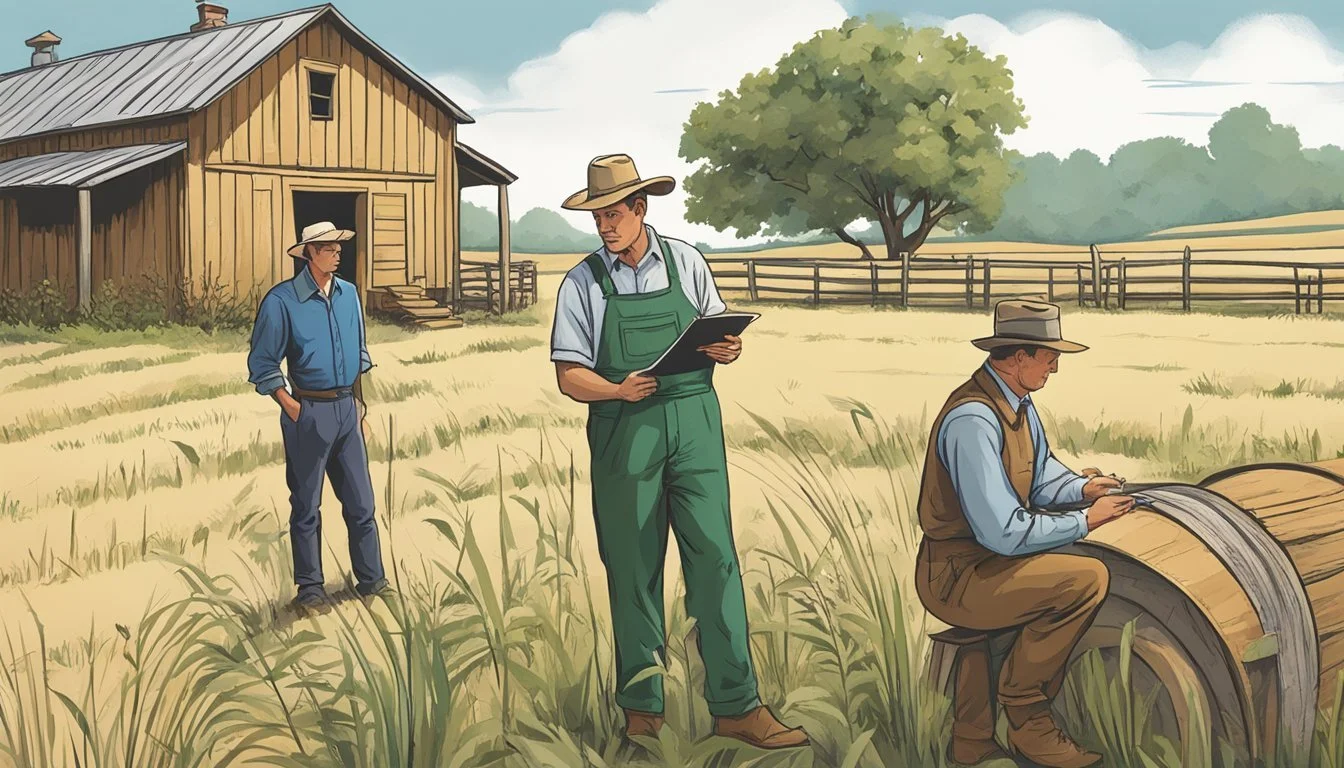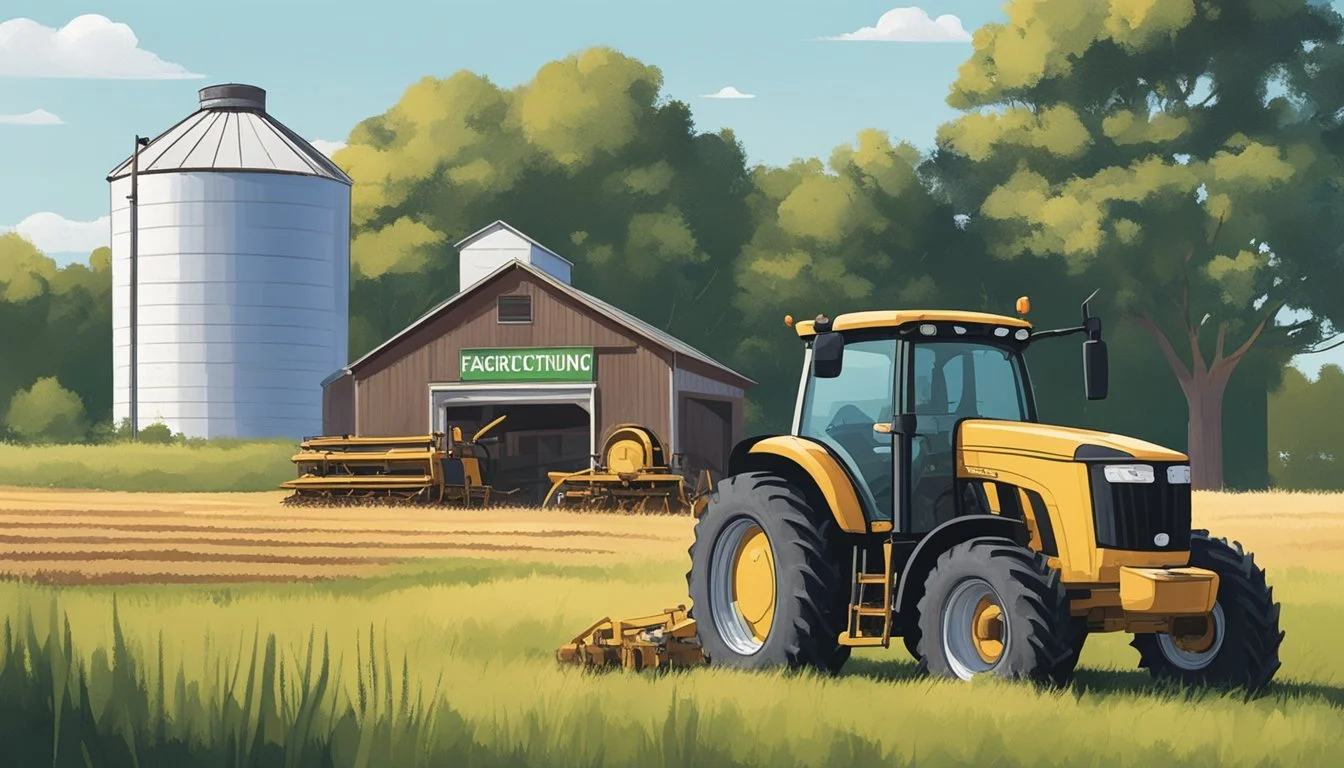Farm Loans in Oklahoma
Navigating Financial Assistance for Agriculture
This Article is Part of Our Guide on Farm Loans for All 50 U.S. States
Oklahoma's agricultural industry plays a crucial role in the state's economy, with farms and ranches operating across its diverse landscape. These agribusinesses require a reliable source of finance to remain operational and competitive. Farm loans in Oklahoma serve this vital function, offering necessary capital to new and established farmers and ranchers. Various programs are available, including those specially designed for beginning farmers, minorities, and women in agriculture, which aim to foster growth and sustainability in the sector.
Access to credit is essential for managing the day-to-day operations, purchasing land, equipment, and livestock, and for handling emergencies that can arise in the farming business. Financial institutions in the state, like Oklahoma AgCredit, Farm Credit Associations of Oklahoma, and Farm Credit of Western Oklahoma, offer specialized loan products tailored to the unique needs of the agricultural community. These loans come with competitive interest rates and flexible terms to fit the different requirements of Oklahoma's agribusinesses.
The Farm Service Agency (FSA), an arm of the USDA, provides additional support through a variety of loan programs. Its services are particularly directed towards assisting beginning farmers and ranchers, underscoring the importance of nurturing the next generation of agriculturists. By acknowledging the challenges that heirs' property owners face, programs like the Heirs' Property Relending Program (HPRP) help secure the future of family farms for coming generations. In this way, a broad spectrum of loan options sustains Oklahoma's agricultural landscape, from small family-owned operations to expansive ranches, underpinning the state's agronomic success.
Understanding Farm Loans
Navigating the landscape of farm loans in Oklahoma requires an understanding of the various types of financial assistance available, the eligibility criteria set forth by lenders, and the steps involved in the loan application process. These loans are essential for obtaining the credit necessary to fund agricultural endeavors.
Types of Farm Loans
In Oklahoma, farmers have access to a range of loan types tailored to their specific needs. Farm ownership loans and operating loans are common, each carrying different interest rates. As of February 2024, for instance, farm ownership loans have an interest rate of 5.375%, while emergency loans offer a lower rate of 3.750%. Additionally, programs like the Farm Service Agency's Beginning Farmers and Ranchers Loans provide targeted support to those new to the industry.
Traditional
Down Payment
Joint Financing
Micro Ownership
Operating Loans
Direct Operating
Micro Operating
Youth Loans
Specialized Loans
Beginning Farmer Loans
Land Contract Guarantee
Eligibility Criteria
Eligibility for farm loans typically hinges on the individual’s credit history, farming experience, and the operation's financial health. Beginning farmers, for instance, may be eligible for loans designed to bolster new agricultural businesses. Lenders also look at financial indicators such as the ability to provide collateral and the farm’s potential profitability.
General Requirements
Satisfactory credit history
Demonstrable experience in farming
Adequate collateral
Specific to Beginning Farmers
Must be first-time farm owners
Must participate in financial management programs
Loan Application Process
Prospective borrowers must follow a structured process when applying for farm loans. This typically includes gathering detailed financial information, completing required forms, and submitting applications to the chosen lender or through official government platforms like https://www.fsa.usda.gov for federal programs. Timelines and specific procedures can vary based on the loan product and lending institution.
Preparation
Gather financial documents
Outline a business plan
Application
Complete the relevant forms
Submit through lender's portal or government website
Review
Lender assesses credit and eligibility
Possible need for additional information
Loan applicants can seek assistance from the USDA Farm Service Agency or consult with financial advisors to ensure a smooth and well-informed application process. Proper understanding of these aspects helps farmers and ranchers in Oklahoma secure the financing they need to thrive.
Financial Resources for Farmers and Ranchers
Farmers and ranchers in Oklahoma have access to a variety of financial resources, including federal and state support programs, Farm Credit services, and agricultural cooperatives which provide essential capital for starting, operating, and expanding agricultural businesses.
Federal and State Programs
The USDA’s Farm Service Agency (FSA) plays a pivotal role in supporting Oklahoma's agricultural community. Key programs include:
Livestock Forage Program (LFP): Assists ranchers suffering pasture losses due to drought.
Emergency Assistance for Livestock, Honey Bees, and Farm-raised Fish (ELAP): Offers aid for feed and death losses.
Livestock Indemnity Program (LIP): Compensates for livestock mortality due to adverse weather.
Noninsured Assistance Program (NAP): Protects against crop yield losses.
Tree Assistance Program (TAP): Provides funds to replant or rehabilitate eligible trees.
The Oklahoma State University Extension offers free farm financial planning assistance to optimize farm operations.
Farm Credit Services
Farm Credit institutions, including Oklahoma AgCredit, provide a backbone of credit and financial services to farmers and ranchers. They offer:
Farm Operating Loans: For purchasing livestock, seed, and equipment or covering operating costs.
Eligibility Assessments: Tools for understanding loan qualifications.
Agricultural Cooperatives
Agricultural cooperatives in Oklahoma offer their members, including farmers and agricultural organizations, resources such as:
Bulk Purchasing: Reduced input costs for seeds, fertilizer, and equipment.
Credit Services: Member-based financing solutions.
Market Access: Facilitating better market prices for their products.
These entities collaborate to ensure financial stability and growth for Oklahoma’s agricultural sector.
Acquiring Land and Livestock
Farm loans in Oklahoma offer robust solutions for individuals seeking to secure land or invest in livestock. It is crucial they understand the specifics of each process to make informed decisions.
Purchasing Acreage
Oklahoma provides opportunities for farmers through various loan options that cater to purchasing rural land. Farm ownership loans can finance up to 100% of the acreage cost, with limits reaching $600,000, which can help farmers acquire the needed land without immediate full capital. The terms of these loans can stretch up to 30 years, offering fixed rates contributing to predictable payments and better financial management.
Loan Features Details Max Financing Up to 100% Max Loan Amount $600,000 Terms Up to 30 years Rate Options Fixed, variable, adjustable Conversion Possibility Convert to fixed rate with minimal cost and time
Properly structured loans are essential for managing risk and ensuring the farmer can maintain a positive cash flow.
Investing in Livestock
As part of managing a successful farm, investing in livestock such as cattle is a significant consideration. Adequate funding is essential for covering the costs associated with livestock purchases. Programs tailored for beginning farmers and ranchers can provide the necessary capital for livestock investment, supporting the growth of agribusinesses.
Livestock loans are generally flexible to meet the various needs of the farm, and having sound financial guidance can aid in choosing the right loan structure. It is advised to contact knowledgeable loan officers or FSA representatives to navigate the specific offerings and eligibility requirements, ensuring one's investment aligns with their business plan and capabilities.
Livestock Loan Considerations Affordability Loan Flexibility Repayment Terms Financial Impact on Farm
Operating Loans for Daily Expenses
Operating loans are essential tools for farmers, allowing them to manage the daily expenses associated with running a farm. These loans are specifically designed to meet the operating cycle needs of a farm and can be tailored to a farm's unique seasonality.
Covering Crop Production Costs
For crop producers in Oklahoma, operating loans serve as vital financial support to cover the upfront costs of planting major commodities like corn, wheat, and hay. These costs can include:
Seeds and planting materials: Vital for starting the crop cycle.
Fertilizers and chemicals: Essential for ensuring crop health and maximizing yields.
Fuel and utilities: For operating machinery and maintaining farm facilities.
Paying for Livestock and Feed
In the realm of livestock production, operating loans provide Oklahoma's farmers with the necessary capital to:
Purchase cattle: Essential for maintaining or increasing herd size.
Buy feed: Critical for the daily maintenance and proper nutrition of livestock.
Veterinary care: Important for maintaining animal health and preventing the spread of diseases.
By utilizing operating loans to cover these costs, farmers can effectively sustain their agricultural production cycles without compromising on the quality of their output or the well-being of their livestock.
Equipment and Infrastructure Financing
Oklahoma farmers have access to a range of financing options designed to support the acquisition and maintenance of agricultural machinery, as well as the construction and upkeep of essential farm buildings and storage facilities. These financial solutions cater to the needs of various farming operations, from small family-run farms to large-scale agribusinesses.
Machinery Purchase and Maintenance
Farmers in Oklahoma can utilize specialized loans for purchasing both new and used equipment, which is fundamental to maintaining the productivity and efficiency of a farm. AgDirect®, offered through financial institutions such as Oklahoma AgCredit, provides flexible financing options including:
Buy, lease, or refinance
Variable or fixed rates
Loan officers work with farmers to tailor finance packages that accommodate unique agricultural needs, ensuring they can procure essential equipment such as tractors and harvesters that are integral to farm operation and success.
Building and Storage Facilities
When it comes to expanding the farm's infrastructure, Oklahoma farmers can secure loans aimed at constructing and maintaining buildings and storage facilities. Vision Bank offers financing options to support the growth and development of a farm's physical assets. Financing for such infrastructure is crucial for:
Protecting equipment: Secure storage minimizes wear and extends the lifespan of machinery.
Safekeeping harvest: Proper storage facilities ensure the quality of produce is preserved from field to market.
Farmers can work with finance professionals to structure loans that build the foundational assets of their farming business, focusing on strategic investment in their operation's longevity and prosperity.
Specialized Loans and Programs
In Oklahoma, various specialized farm loan programs are available to support distinctive groups such as beginning farmers, youth interested in agriculture, and those looking for joint financing. These programs are designed to provide targeted financial assistance, fostering the growth and sustainability of the agricultural sector.
Beginning Farmers and Ranchers
The Oklahoma Beginning Farmer Loan Program assists newcomers to farming by offering credit options for capital investments. These investments can include purchasing agricultural land, equipment, and livestock. For beginning farmers, this program is crucial in overcoming the initial financial barriers to entering the agricultural industry.
Eligibility: Farmers considered "beginning" if they have operated a farm for less than 10 years.
Uses: Capital items such as land, machinery, equipment, and livestock.
Joint Financing Options
Joint financing arrangements are available to farmers who require larger loans or who may benefit from sharing the financial burden of large agricultural ventures.
Definition: Joint financing refers to loans where a borrower and a lender share the cost of purchasing needed items.
Advantage: Reduced down payment, potentially leading to immediate operational expansion.
Youth Agricultural Projects
Youth loans provide a pathway for young individuals in Oklahoma aiming to engage in agricultural projects. This program is specific to those under 20 years old and supports projects such as income-producing, educational, agricultural endeavors guided by 4-H or FFA organizations.
Age Requirement: Must be between 10 and 20 years old.
Supervision: Projects must be under the direction of 4-H clubs, FFA, or a similar agricultural youth organization.
Risk Management and Insurance
Farmers and ranchers in Oklahoma face a variety of risks including natural disasters and market fluctuations. Effective risk management and farm insurance are vitally important in safeguarding their livelihoods and ensuring the stability of rural communities.
Dealing with Natural Disasters
Oklahoma's farmers and ranchers may contend with natural disasters such as drought and fire, posing significant threats to their operations. The Non-insured Crop Disaster Assistance Program (NAP) offers a safety net against losses caused by these events, while Emergency Assistance for Livestock, Honey Bees and Farm-raised Fish (ELAP) provides crucial aid for eligible producers.
The USDA Farm Service Agency also administers the Livestock Forage Program (LFP), designed to compensate ranchers experiencing pasture loss due to drought. Moreover, during extraordinary circumstances like the COVID-19 pandemic, targeted emergency loans are often available to support and sustain the agricultural community.
Insurance for Crops and Livestock
Federal crop insurance and the Beginning Farmer and Rancher Benefits for Insurance provide critical risk management tools. These measures protect against the loss of crops due to natural disasters and price fluctuations.
Additionally, the Livestock Indemnity Program (LIP) offers compensation to ranchers who have lost their livestock due to adverse weather events or attacks by animals reintroduced into the wild by the federal government. Trust in these programs is key for farmers and ranchers to invest confidently in their crops and livestock, with the assurance that they can endure unforeseen setbacks.
Supporting Rural Oklahoma
Rural Oklahoma's economy is largely supported by its robust agriculture sector, which includes a diverse array of farms and ranches. Access to financial resources is critical for these agribusinesses to thrive. The Farm Service Agency (FSA) of Oklahoma, for example, plays a key role in facilitating growth by offering commodity, conservation, credit, and disaster programs designed to stabilize and support the rural economy.
Farmers and ranchers in need of financial assistance may consider various loan opportunities. Farm Operating Loans can provide access to lines of credit for daily business operations, while options for Real Estate Financing are available for purchasing land. Additionally, specialized services like Risk Management help safeguard against unpredictable elements that could affect their agricultural ventures.
In the pursuit of financial resources, farmers, especially those operating smaller-scale or specialty crop farms, may look toward grants and micro-loans. These funds can assist in aspects such as:
Operation expansion
Market reach extension
Diversification of the farm operation
Sharing knowledge and experiences with other producers
Moreover, institutions like Farm Credit of Western Oklahoma offer consistent support, catering to agriculture and rural community loans that solidify the presence of agribusinesses in the area.
Understanding and navigating debt relief and financial assistance programs is crucial for many residents. Foundational support for Oklahoma's rural economy hinges on accessible, informed guidance through these financial channels, which ensures the steady operation of the state's farms and ranches.
Loan Payment and Refinancing Options
When exploring farm loans in Oklahoma, understanding loan payment calculations and refinancing options is crucial. This section specifically addresses the mechanics of calculating monthly payments and the avenues for restructuring existing debts on farm properties.
Calculating Monthly Payments
To calculate monthly payments on farm loans, lenders factor in the loan amount, interest rate, and loan term. Monthly payments are determined by an amortization formula that distributes payments over the loan's lifespan, which typically includes both principal and interest. Borrowers can use online loan payment calculators to estimate their monthly financial commitment, thus enabling proactive budgeting for farm-related expenditures.
Restructuring Existing Debt
Farmers in Oklahoma seeking to manage their finances more effectively can consider debt restructuring. Refinancing options provide the opportunity to secure lower interest rates or adjust the loan's term, potentially reducing monthly payments and improving cash flow. This involves replacing an existing loan with a new loan, often with different terms that are better suited to the borrower's current financial situation. It's important that borrowers closely examine the terms of the refinancing offer to ensure it aligns with their property goals and financial capabilities.
Navigating Legalities and Regulations
In Oklahoma, farm loan applicants must have a clear understanding of the federal and state regulations that govern agricultural lending. They should also be aware of the steps required to secure property rights to ensure compliance and eligibility for these financial programs.
Understanding Government Regulations
Farmers and ranchers seeking operating loans or other forms of financial assistance must navigate a complex framework of government regulations. The primary source of such regulatory information is found through various .gov websites, such as the USDA Farm Service Agency, which offers detailed guidance on loan eligibility and application processes. Applicants should familiarize themselves with the Inflation Reduction Act provisions that affect agricultural communities, including those related to distressed borrower relief.
Federal Laws: Comprehend the federal laws detailed by the USDA, which include programs created under acts such as the Inflation Reduction Act.
State Laws: Investigate pertinent state-level agricultural statutes that can affect farm loans.
Key Resources:
USDA Farm Service Agency: www.fsa.usda.gov
Oklahoma State Office - USDA Farm Service Agency
Securing Property Rights
For farmers to capitalize on agricultural loans, securing farmland property rights is crucial. This includes ensuring that titles are clear and that all property transactions comply with local and state laws. When acquiring agricultural land, a precise understanding of property rights can prevent future legal complications, especially when the land is used as collateral for loans.
Title Search: Conduct a thorough title search to confirm ownership and uncover any liens or encumbrances.
Zoning Laws: Check local zoning laws to confirm that the land's use aligns with agricultural purposes.
Securing property rights is a foundational step not only for owning and operating agricultural land but also for qualifying for various farm loan programs offered by the government.










